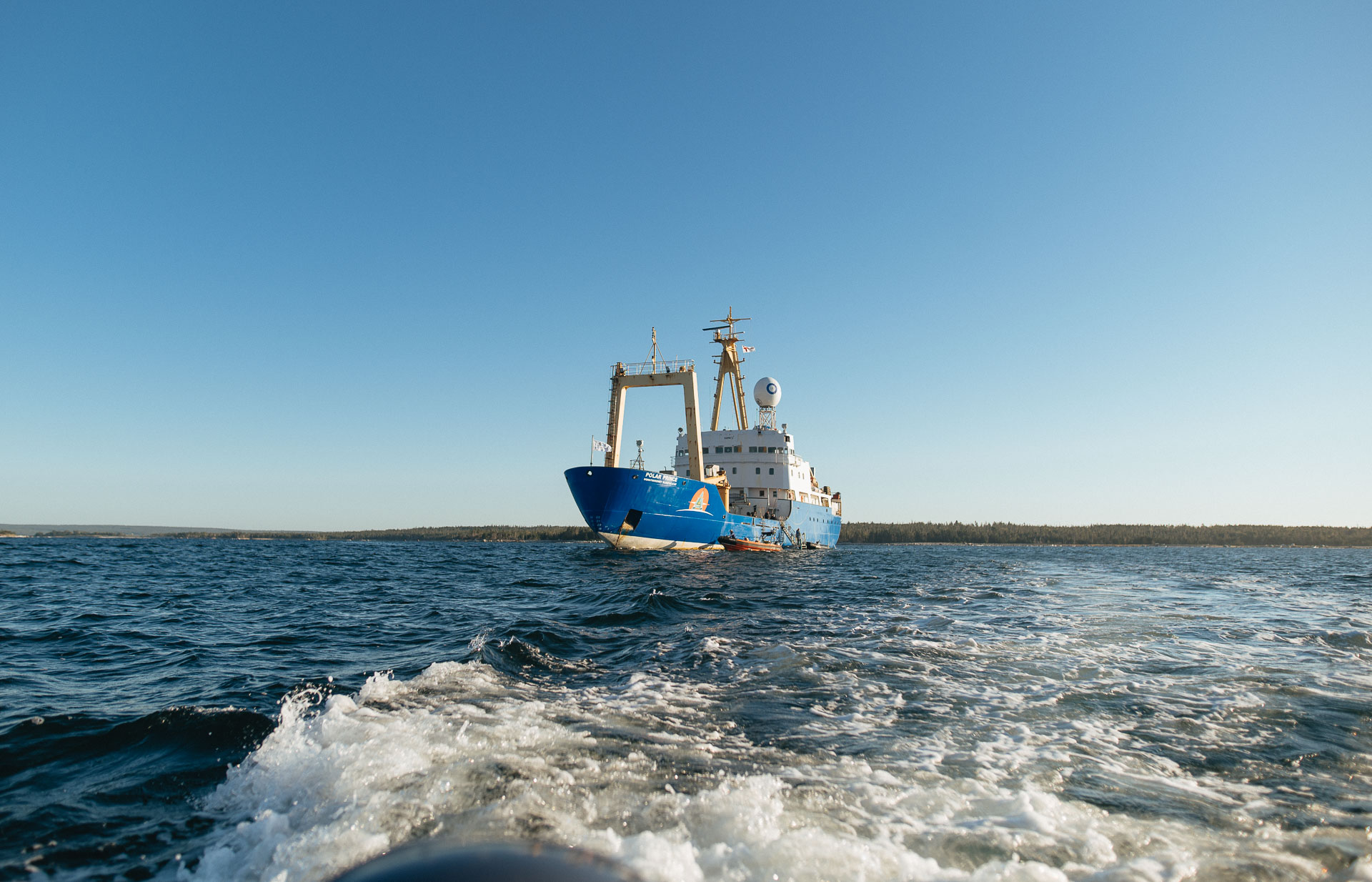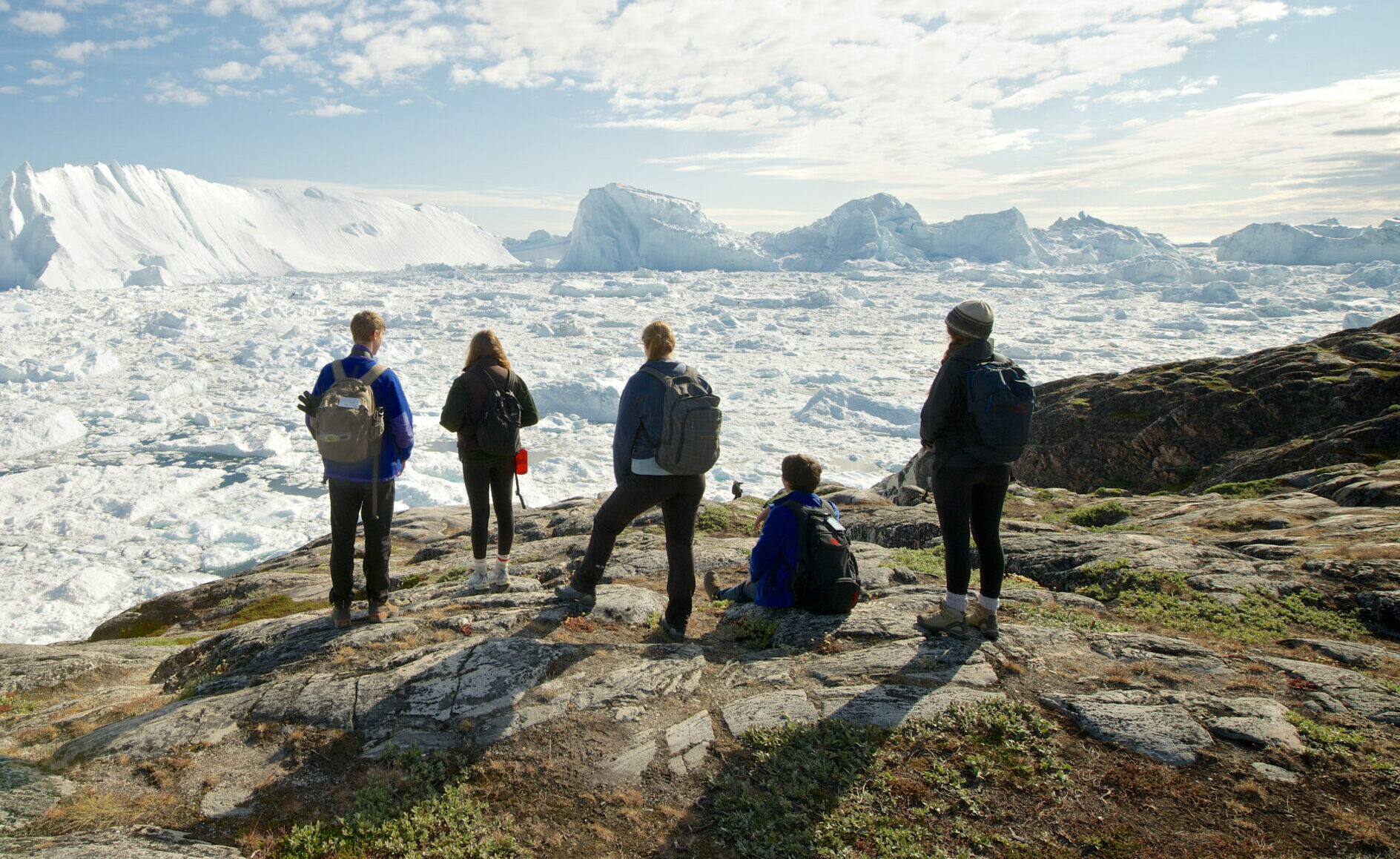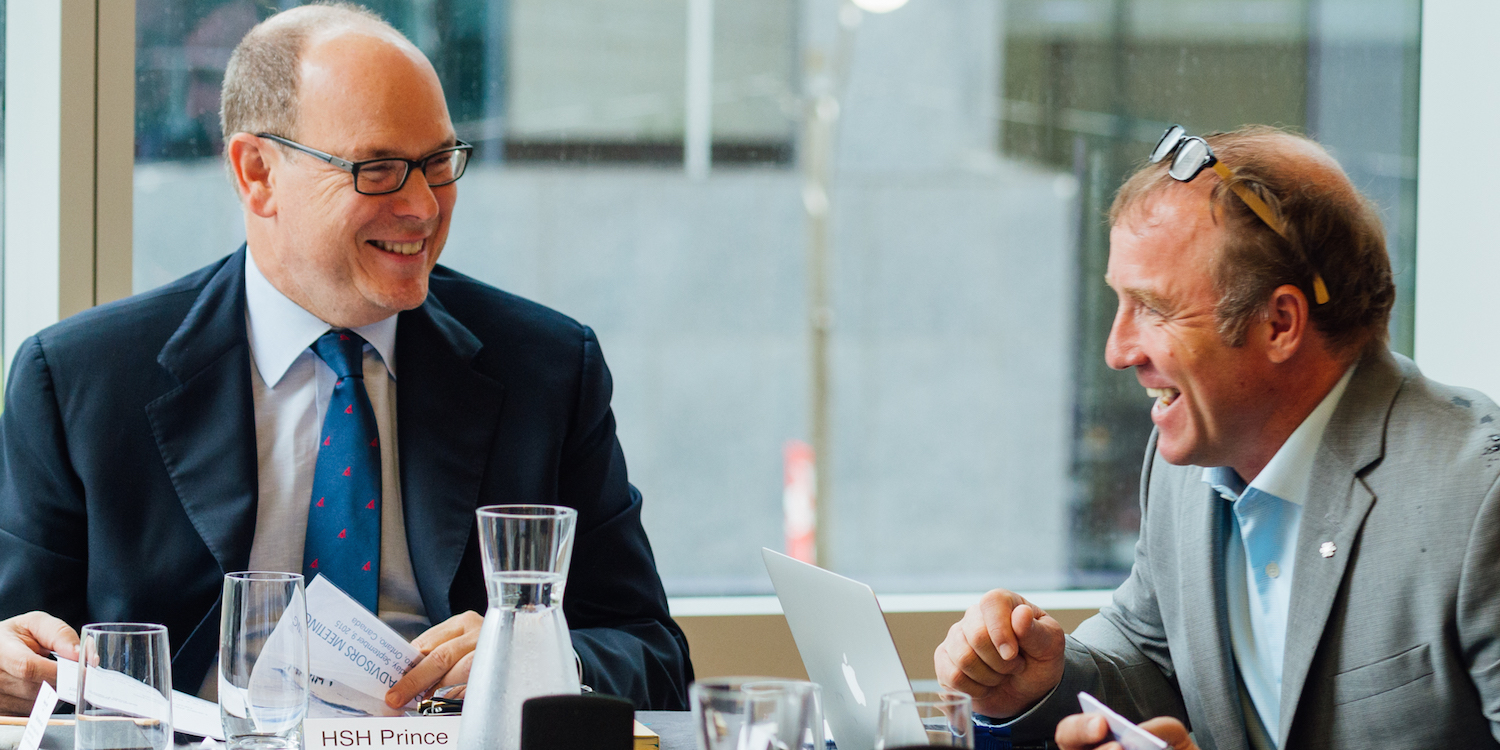Kalaallit Nunaat to Nunavut Expedition: Full Recap
This blog is a reflective account written by youth participants of the 2024 Kalaallit Nunaat to Nunavut Expedition. Through their collective voices, they share experiences, challenges, learning outcomes, and the meaningful connections they made throughout the journey to themselves, each other, and to nature.
“Whether it be zipping through the waters on a zodiac and feeling the cold rush of air on my face, staring out at the extensive landscape from the top of a mountain, watching an iceberg calve right before my eyes, or jumping into freezing water, I’m entirely present and my mind is momentarily free. It is so indescribably liberating and makes me feel alive.”
– Cassiana Silva Young, Montreal, QC
In pursuit of an extraordinary Arctic learning experience, our diverse group assembled in Ottawa and over our first dinner together, we exchanged stories about who we are and where we come from. Two of our participants shared what they were most looking forward to:
“I’ve recently taken a keen interest in birding and identifying native species. I am looking forward to connecting with the High Arctic through storytelling, experiencing the expedition and making new friends.”
– Grant Penney, Corner Brook, NL
“Whale watching is what I’m most looking forward to, mainly because they are beautiful, interesting and extraordinary animals in the Arctic. I’m also intrigued to learn more about Inuit across different regions of the North; to meet people and listen to their background and share mine.”
– Siasi Audlaluk, Ivujivik, QC

With the group’s excitement becoming palpable, we made our final preparations for the 17-day journey from Kangerlussuaq, Kallaalit Nunaat (Greenland) to Qausuittuq, (Resolute) Nunavut. Our immersive experiences in the High Arctic demanded the attention of all five senses, leading us to learn and share new ideas. Throughout this blog, we reflect on the themes of climate change, intergenerational learning, and the importance of community.
The Threat of Climate Change to People and Place and Sustainable Solutions
In Ilulissat, glaciologist and expedition guide Yvonne Cook explained that the Sermeq Kujalleq glacier (a large outlet glacier terminating in the Ilulissat Icefjord) drains 6.5% of the Greenland ice sheet and produces 10% of all Greenlandic icebergs. We reflected on the Icefjord’s environmental significance as a channel between the Greenland ice sheet and the ocean. Climate change has resulted in icebergs flowing out of the fjord faster than the ice sheet builds back up. This huge addition of freshwater lowers the salinity and changes the density of water in the Arctic, threatening to disrupt major ocean currents upon which global human and ecological communities depend.
“As Inuit, climate change not only threatens our land and water but threatens our very identity and culture as well.”
– Elia Lauzon, Kuujjuaq
Climate change is often discussed in terms of carbon dioxide and other greenhouse gases. Amongst the icebergs and our Inuit peers, we began to understand that climate change is so much more than concentrations of CO2. We were called to grapple with the stark social injustices of climate change. Across the globe, those who have emitted the least carbon are those whose cultures, livelihoods, and families are most at risk. As Korey explains, “our emotions flowed like glaciers,” as we began to better recognize the pain that climate change is inflicting upon the people and ecosystems of the North.
Capsules of adventurous memories.
A current of powerful emotion from the flow of captivating glaciers
Heart pulses as strong as a steep lunge over a breathtaking canyon
A timelapse of the midnight suns
The most wise advice if you see a polar bear be sure to stare
– Korey Lyons, Sitansisk, N.B.
Given the less-than-positive climate prospects for the Arctic, many of us have been wrestling with how we stay hopeful. One lesson in hope came from a polar bear in Croker Bay, Tallurutiup Imanga, we saw eating a seal. We witnessed the bear kill the seal in the water and drag it up an iceberg to eat it. This is an incredibly rare sighting – polar bears typically hunt from sea ice, and as sea ice coverage decreases, so do their hunting grounds.

Polar bears are often portrayed as helpless victims of climate change, so this sighting was an inspiring sign that polar bears are in fact adapting to a changing world. In many ways, this is what we are all attempting to do. Climate change has meant we are not living in the same world our parents grew up in. For many of us, traditional knowledge about living on the land is no longer as accurate as it once was because of rising temperatures and increasingly unpredictable weather. We must all find ways to adapt; just because it is going to change doesn’t mean we should give up.
Elevating Intergenerational Learning by Bridging Indigenous Knowledge with Western Perspectives
Throughout our time together, it became clear that we all had much to learn from one another. All those participating in our expedition were from different geographical and cultural backgrounds, each with unique stories of who we are, and where we come from. The exchange of intergenerational teachings occurred mainly through language.
One evening, while crossing the Davis Strait, one of our participants, Igima, watched in awe as seabirds drifted and swooped behind our ship. Intrigued, Igima asked his fellow participants if they knew what these birds were called. In English, they are called Northern Fulmars, a long-lived and widespread seabird of the Arctic, with a special salt gland above their bill to help get rid of excess salt in their bodies. Keen to learn more about Arctic birds and their Inuktitut names, Igima texted his mother, who emphatically responded with a long list of the Inuktitut names for various birds. We were particularly interested to learn the Inuktitut name of the Snow Bunting, and that there were actually three different names: a general term, a name for the birds in the winter when their feathers are white, and a name for birds in the summer when their feathers are black:
Snow Bunting / Qupannuaq
White Snow Bunting / Qauluqtaaq
Black Snow Bunting / Qirniqtaaq
– Igima Rojas, Iqaluit, NU

A few seconds later Cruise jumped in to say, “The Mi’kmaq name for crow is Ka’qawej, which when spoken, sounds just like the noise they make.”
What is profound about these bird names, and language more broadly, is that they directly represent a culture and a worldview. In speaking a language, you immediately reconnect with the peoples who created and spoke the language over centuries, and the wisdom contained within it. Indeed, in describing birds relative to how they sound, or how the colour of their feathers changes through the seasons, the speaker translates valuable local knowledge to the listener. This descriptive bird naming was mirrored by recent efforts in western science as well. As a means of creating a more inclusive naturalist community, bird names that currently include an honorific (the name of the naturalist who “discovered” them), are slowly being changed to descriptive names that describe something about how the bird looks or interacts with its environment. After discussing this small example of how the incorporation of Indigenous wisdom can change western society for the better, we were left wondering what other western practices could benefit from some reform informed by Indigenous knowledge? How can western society take inspiration from Indigenous culture and language while simultaneously uplifting them?
One answer to this question came in the form of a presentation from expedition staff, PhD student, and glaciologist Wilson Wai Yin Cheung. Wilson’s research seeks to understand how glacial ice on Baffin and Bylot islands is changing as a result of climate change. His findings will help to further refine how the Intergovernmental Panel on Climate Change (IPCC) measures and reports glacial ice melt and sea level rise. Crucially, Wilson has also meaningfully engaged the Inuit of Mittimatalik (Pond Inlet) in support of his research. In a reciprocal approach to teaching and learning, Wilson works with Parks Canada and Mittimatalik to ensure his work gives back to the communities he works in. As educators, scientists, and ocean professionals, we all are responsible for honouring intergenerational wisdom and implementing “reconcili-action”.
Building Towards Resilient Human and Ecological Communities

After crossing the Davis Strait and entering the waters of Nunavut, we were overjoyed to learn that we would be visiting both Mittimatalik (Pond Inlet) and Ikpiarjuk (Arctic Bay). Both communities offered a warm welcome to SOI participants. Onshore, many SOI staff and educators were embraced with big bear hugs as they reconnected with friends and SOI alumni. Both communities shared beautiful cultural performances with ethereal singing and music, athletic prowess, and many laughs. The strength of Inuit culture was juxtaposed with the apparent challenges of life in the North. SOI participants walked through the aisles of grocery stores and gained a new understanding of food and economical scarcity in the North. Our experiences in Canadian Inuit communities offered us all the chance to reflect on how systemic changes in food systems and ecotourism may build prosperous communities in the future. As a group, we analyzed principles of regenerative tourism and brainstormed avenues by which expedition travel can elevate the communities that are visited and create thoughtful visitor experiences.
“In the North, people often come from and go in an extractive way; it’s about them, not about our communities”
– Frederick Hutchings, Iqaluit, NU
So where does hope come from? There are many answers to that question, and one we have discovered in particular is community. These communities are advancing conservation initiatives through co-management agreements to protect the lands and waters of the Arctic on their own terms. A recent example and one that SOI has been involved with since 2016, is the agreement that governs the Tallurutiup Imanga National Marine Conservation Area, which is led by a board made up of equal Inuit–Canada representation that makes consensus-based decisions while taking Inuit Qaujimajatuqangit into account. This approach not only ensures that traditional Inuit knowledge and perspectives are integral to the management process, but also fosters a collaborative relationship that respects and integrates both Indigenous and scientific insights, while also protecting important Arctic habitat.
“In the same way that interconnected and biodiverse ecological communities are the most resilient, I think strong communication, connections, and diverse voices are key to the creation of thriving human societies too.”
– Liam Brennan, Ottawa, ON
Both Peter Berthelsen and Iben Lange (renowned Greenlandic chefs and Expedition Staff) were also pillars of hope during our expedition. On the final night, they surprised SOI staff and participants with a marvellous “Tundra to Table” culinary experience. With skill, cultural wisdom, and generosity, they created delicious food that warmed the bellies and hearts of us all. By integrating their cultural culinary backgrounds into Quark’s expeditions and ensuring 50% of the Tundra to Table proceeds go back to youth social programs in Greenland, they showed us a perfect example of how ecotourism can become regenerative tourism and uplift northern communities.

We’ve also found much hope within our own community. Based on each of our work in the field or in our studies, we all deeply care about Arctic ecosystems and communities and, more broadly, the state of the planet. It’s exciting for us to see more opportunities to voice our hopes for the future, both on this expedition and beyond.
Next Steps
As we engaged with and learned from the diverse voices within these Arctic communities, we were inspired by their resilience and innovative approaches to environmental stewardship. This experience has ignited a shared commitment among us to advocate for sustainable solutions and contribute to a positive impact, ensuring that the lessons we’ve learned translate into meaningful action for the preservation of our planet.
“[My time with SOI, reminded me of a] teaching from the Métis beadwork I do. In all beadwork, artists place a ‘spirit bead’ – an intentional mistake or wrongly coloured bead – in the design. This bead is added to show that none of us is perfect – only the Creator is perfect. I can make commitments to live more in line with my values, but I also owe it to myself to take advantage of the incredible opportunities that I’ve been given, which include flying to Greenland to experience the Arctic. It is my hope that my experiences from this expedition will deepen my commitment to conducting research on environmental justice, thus leading to eventual environmental good. As a future researcher, I want to drive people and communities to act not from the fear of what is happening to the planet, but from the hope that we are capable of coming together and creating positive change.”
– Gabrielle Moreau, Toronto, ON

While acknowledging that none of us are perfect, the adventure of being SOI alumni begins today. We will carry this experience and these teachings with us as we navigate the early stages of our lives and careers. From a small act of inclusion in our workplaces, to incorporating reconciliation into Western science, the time is now for us to start creating change within ourselves and our institutions.
Thank you to the partners who made this expedition possible, including Adventure Canada, Canada Goose, Canadian North, Equinor, Government of Nunavut – Department of Environment, Inuvialuit Regional Corporation, Kakivak Association, Kativik Regional Government – Sustainable Employment Department, Leacross Foundation, Makivik Corporation, Power To Be, Quark Expeditions, and Ulnooweg.





